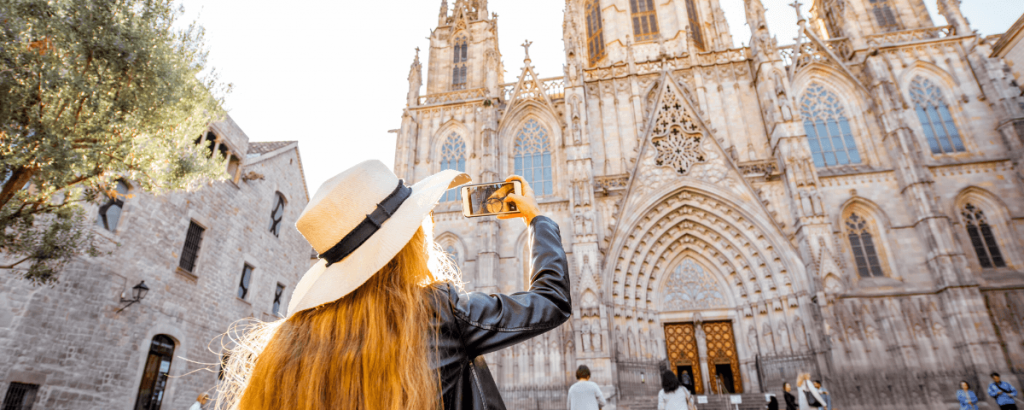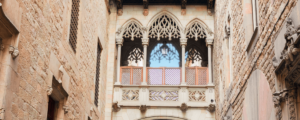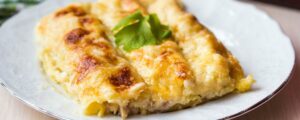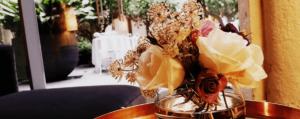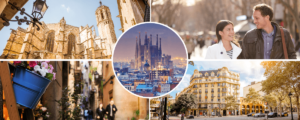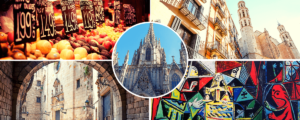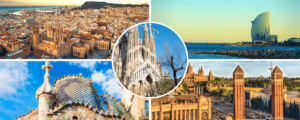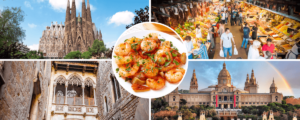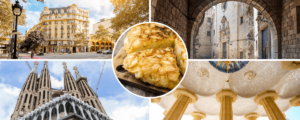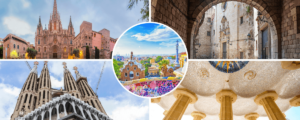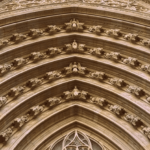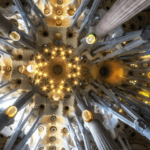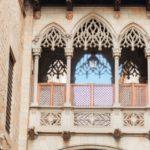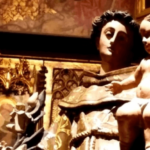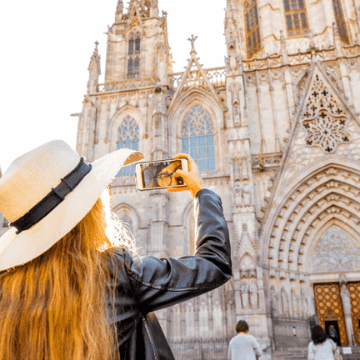
La Seu, Cathedral Of Barcelona
THE BARCELONA CATHEDRAL INTERIOR & MORE
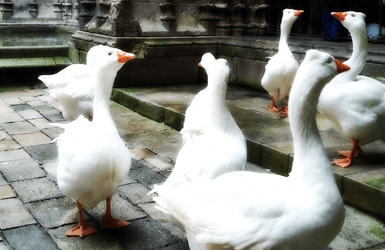
There's only one Cathedral in Barcelona, and that's not the Sagrada Familia! Not any big church becomes automatically a Cathedral: the Cathedral is the headquarters of the local bishop. And since the bishop is the "boss" of the Christians in a city, there's only one Cathedral in each city, too. And the Bishop isn't moving to Sagrada Familia just because it's bigger, LOL: tradition matters, and the Cathedral of La Seu has been the Barcelona Cathedral for many centuries.
And because it’s the only one in Barcelona, locals call this building “THE Cathedral”, and that’s it. But it’s full name is Cathedral of the Holy Cross and St. Eulalia. You might also hear it referred as La Seu or Cathedral of La Seu. “La Seu” is a Catalan synonym for “The Cathedral” – both words refer to the “seat” (headquarters) of the Bishop. So calling it “Cathedral of La Seu” is a bit redundant… but it works.
During our tours lot of people tell me they’ve seen too many churches already. But actually, visiting a Barcelona Cathedral can be fun: it all depends on the stories that are hidden there and how those stories are explained. I have actually had kids telling me “This is the only time I have ever enjoyed being inside a church!”. That’s why the Cathedral of Barcelona is one of the top sites of our Gothic Quarter tour, despite not even being one of the most famous cathedrals in Europe!.
Brief history of the Cathedral at Barcelona
- V-VII centuries. The origins of the Cathedral of Barcelona date back to a Paleo-Christian basilica located in the same spot. It may have suffered damage during the Muslim occupation in the 700’s or even have been reused as a mosque. In 877 Bishop Frodoi moves the relics of St. Eulalia to the Basilica.
- 997-1058. The Basilica is already a Cathedral when it’s attacked by the Muslims again, so it needs to be reconstructed. A new larger Romanesque building is built.
- 1298-1448. The old Romanesque building is progressively dismantled to allow for the construction of a larger Gothic Cathedral, that also includes a cloister.
- 1519. The Cathedral of Barcelona hosts the meeting of the Toison d’Or, presided by king Charles I of Spain and V of Germany. For that the choir is embellished with coats of arms.
- 1882-1913. Thanks to the donations of Manuel Girona and his heirs, a new Neo-Gothic façade is built to replace the old one, that lacked of charm. As a guideline, they use the medieval plans that had never been executed and that were found in the Cathedral archives.
- Recent times. The Gothic Cathedral in Barcelona has undergone several restoration campaigns since the end of the XXth century. The first one was to prepare for a Royal wedding: that of the daughter of the King, Cristina, with the handball player Iñaki Urdangarin (divorced in 2023). Also in 2023 a Samsung add sponsoring the Cathedral had to be retired as people considered it unappropiate.
The Barcelona Cathedral from outside
1
The Façade
The façade of the Cathedral of Barcelona isn’t really Gothic, but Neo-Gothic (Gothic revival= instead, as it was built in the late 1800’s. However, it features a lot of medieval symbolism. A sculpture of Jesus stands in the middle of the central door, flanked by the 12 apostles.
2
The Sta. Llucia Chapel
The only chapel accessible from the street (besides the main nave) is this tiny one dedicated to St. Lucia, located in the corner of Bisbe and St. Llucia streets. This used to be a stand-alone chapel belonging to the nearby Bishopric Palace when it was built 1000 years ago in Romanesque style, and it became part of the Cathedral when the cloister was built 500 years ago. It can actually can be accessed from the cloister as well, but when the door facing the street is open, the chapel can be used for prayer, and then the door connecting with the cloister is closed. When the street door is closed, the chapel can only be visited from the cloister.
The chapel gate that opens to the street is decorated with round arches carved with leave relieves that are considered a medieval herbal collection. The inside preserves the tombs of a bishop and a canon.
3
The gargoyles
Interestingly, the gargoyles in the apse (the backside of the Cathedral) aren’t monsters but animals such as horses, elephants, cows… even a unicorn! They are thought to represent the virtues a Christian should have to go to Heaven, instead. You’ll see them from the corner of Comtes and Pietat streets.
4
The gate of St. Iu
The Gate of St. Iu (Saint Ivo of Kermartin) opens to Comtes street and it’s a side entrance to the Cathedral that usually remains closed. It’s considered the oldest gate of the Cathedral, and it was used as main entrance during the construction of the Gothic building. While it’s dedicated to St. Ivo, the sculpture that tops the gate isn’t him but the first patron saint of Barcelona: Saint Eulalia. The gate is named after Ivo of Kermartin because he is the patron saint of lawyers, and the building across the street was occupied by lawyers years ago.
The gate is also decorated with musician angels, and scenes of men fighting evil. There’s also a fawn, two owls and a lioness with her cubs. To the sides of the gate you’ll also see two old inscriptions in Latin, both displaying the same text celebrating the start of the construction of the Gothic Cathedral.
Cathedral of Barcelona inside highlights
5
The Christ of Lepanto
But the most important item in this chapel is the sculpture of the Christ of Lepanto, which accompanied king Joan of Austria on his ship during the Battle of Lepanto in 1571. The body of Christ is slightly titled to one side: According to the legend, the sculpture was originally straight but during the battle it come to life to dodge a cannonball, saving the King’s ship, and then it remained tilted forever.
6
The Baptistery
The chapel to the left of the entrance of the Cathedral is the Baptistery. The Baptism font is an Italian piece made in Carrara marble in 1433. It is said to have been where the first Indians brought by Columbus where christened after his return from his first trip in 1493. Columbus was meant to meet the Catholic Monarchs Isabella and Ferdinand in Barcelona when he’ll come back.
7
The Choir
They are tiny: just big enough to rest on them, but not too big to fall asleep during the service… However, during other events such as meetings, the monks where allowed to flip the mercy chairs down and then they become quite comfortable armchairs! Check out their decoration: one of them represents a hockey game!
Over the seats you’ll see the coats of arms of the members of the Toison d’Or that attended a meeting here in 1519: King Charles I of Spain and V of Germany, who convocated them, his grandfather the Emperor of Austria, King Henry VII of England (who didn’t attend in person but sent an ambassador instead), the kings of France and Portugal and many important noblemen, knights and bishops from all over Europe.
8
The side chapels
The side chapels alongside the Cathedral occupy the space between buttresses, that used to be rented out to guilds, brotherhoods and orders of chivalry. Each one was dedicated to the tenant’s patron saint and decorated following the art style that was in fashion on that time, be it Gothic, Renaissance or Baroque. It was common that a chapel would change hands, and the new occupants would redo the decoration and place their own patron saint in a place of honor, maybe still keeping the previous saint on a side. Some side chapels were also used as burial place of important people such as religious personalities and saints, noblemen and even members of the royal family.
9
The Crypt of St. Eulalia
BTW, there are more saints with interesting stories in our Cathedral!
10
The rooftop
Not many people realize that in a side chapel to the left of the main altar there is an elevator that takes you to the rooftop of the Barcelona cathedral. From there you get a superb view of the city, specially over the Old Town, the port and the Hill of Montjuïc.
And you also get a close view of the bell towers. On the central tower hides a sculpture of a snail, that used to mark the entrance to a spiral staircase. Check out this video that I shared on my social media some time ago, and try to see if you can find it!
11
1000yo Tombs
There’s many mausoleums in the Cathedral of Barcelona, but there’s two tombs that stand out (after that of St. Eulalia in the crypt, of course). You will see them to the right of the altar: two wooden coffins surrounded by wall paintings. There lie the founders of the Romanesque Cathedral, Count Ramon Berenguer and his wife Almodis, although it is possible that the coffins also keep the remains of Count Ramon Borrell and Queen Peronella of Aragon, known to have been buried in the Cathedral and whose tomb locations are unknown.
Not far, two stone coffins hanging on a wall preserve the remains of two more counts and four queens of the Crown of Aragon.
12
The Cloister and its geese
What one doesn’t expect to in the cloister of a cathedral, though is animals… And the definite rock stars of the Barcelona cathedral are the 13 geese that live in the cloister: one for each year Saint Eulàlia was old when she was tortured 13 times. They were also there to alert the monks when a thief entered at night: geese were such a noisy medieval alarm!
13
The Museum
A gate that opens to the cloister gives access to the Museum of the Cathedral. There you’ll find fine pieces of Gothic paintings by top Catalan medieval artists, gorgeous embroidery altar clothes and other exquisite religious art pieces. One of the two museum rooms, the New Chapter Room, features a stunningly painted baroque dome.
La Seu Cathedral of Barcelona throughout the year
The Cathedral and its surroundings are the perfect setting for many religious and traditional events. Here are some that might be taking place during your trip to Barcelona:
- Sunday at noon (except Summer holidays). Watch the locals do the sardana dance, on Plaça Nova in front of the main façade of the Cathedral.
- Thursday, Friday and some weekends and holidays. Shop for antiques at the flea market Mercat Gotic, on Plaça Nova.
- March 6. It’s the only day when people are allowed to visit the chamber where the uncorrupted body of Saint Olegarius is kept.
- Easter. See the Christ of Lepanto from closer: since it’s used during the Easter processions, they don’t keep it on its usual location on the Chapter Room but in a side chapel next to the Baptistery.
- May 3. Attend the benediction of the city from the rooftop of the Cathedral, on the occasion of the festivity of the Holy Cross.
- May 22. Bring a rose to Saint Rita (chapel on the cloister) and ask her for your wish to become true.
- Week of Corpus Domini (either end of May or beginning of June). Watch the dancing egg at the cloister of the Cathedral.
- Days around September 24. During La Merce festival a stage is set up in Plaça Nova and here take place concerts and traditional performances.
- Last week of November and until Christmas Eve. Visit the Santa Llucia Christmas market, on Plaça Nova.
- Christmas Eve. Listen to the Cant de la Sibila song, then attend the Missa del Gall mass.
Prepare your visit of the Barcelona Cathedral
14
Visit opening hours and Mass times
The rule of thumb is that during mass times visitors aren’t allowed inside (you can technically enter and stay in the area behind the choir, or access the cloister from the street – but that’s all). And outside mass times, visitors can go inside paying an entrance fee, and parishioners can only access for free the Chapter Room for prayer and daily mass.
Visit hours
- MON-FRI: 9.30AM to 6.30PM (last access 5.45PM)
- SATURDAY: 9.30AM TO 5.15PM (last access 4.30PM)
- SUNDAY: 2PM TO 5PM (last access 4.30PM)
Mass and prayer schedule
Mass is said in Catalan, except those at noon and 6PM, which are in Spanish.
| Schedule | MON-FRI | SATURDAY | SUNDAY |
|---|---|---|---|
| 8.45AM (Laudes) | Chapel of the Most Holy | Chapel of the Most Holy | -- |
| 9AM | Chapel of the Most Holy | Chapel of the Most Holy | Main Altar |
| 10AM (Laudes) | -- | -- | Choir of the Cathedral |
| 10.30AM | -- | -- | Main Altar |
| 11AM | Chapel of the Most Holy | Chapel of the Most Holy | -- |
| 12 Noon | Chapel of the Most Holy | Chapel of the Most Holy | Main Altar |
| 1PM | -- | -- | Main Altar |
| 5.45PM (Rosary) | -- | Chapel of the Most Holy | Chapel of the Most Holy |
| 6PM | -- | Chapel of the Most Holy | Main Altar |
| 6.45PM (Rosary) | Chapel of the Most Holy | -- | -- |
| 7PM | Chapel of the Most Holy | Chapel of the Most Holy | Main Altar |
15
How to get there
Address
Pla de la Seu s/n 08002 Barcelona (Spain)
Transportation
- Closest subway stations: Jaume I (L4, yellow line) and Liceu (L3, green line)
- Bus lines stopping in Via Laietana: 47, V17, V15 and 120.
- Hop-on hop-off bus: Red route.
- Closest parking lot: Saba Catedral and Saba Bamsa Francesc Cambo, both accessed from Plaça d’Antoni Maura.
16
Dress code
Dress code isn’t an issue when you are visiting in the winter, because you’ll be dressing warmly. But when the heat starts people tend to wear shorter clothes and that can be a problem, specially for the ladies. Make sure to wear tops that cover your shoulders and backside, and that the neckline isn’t too deep. A good trick is to carry a light shawl with you that you can throw over your shoulders. Trousers, skirts, dresses and shorts should be around knee high or longer.
17
A Cathedral in Barcelona Gothic Quarter...
The Barcelona Cathedral is the most important building in the Gothic Quarter, so it’s a good idea to time your visit with other things to do in the area. Here are some ideas from our blog:
And here are some of our private tours around the Gothic Quarter, that can include the inside of the Cathedral of Barcelona on request:
Will you be visiting the Cathedral at Barcelona?
Marta
RESEARCHING FOR A TRIP IS TIME-CONSUMING…
Need more inspiration?
Our 100% FREE Barcelona Collection will give you everything you need to organize the trip of your lifetime to Barcelona.
BEST INSIDER TIPS FROM THE PROS!


